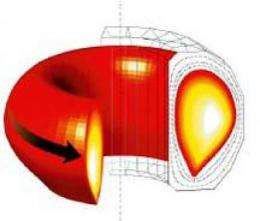High-performance plasmas may make reliable, efficient fusion power a reality

In the quest to produce nuclear fusion energy, researchers from the DIII-D National Fusion Facility have recently confirmed long-standing theoretical predictions that performance, efficiency and reliability are simultaneously obtained in tokamaks, the leading magnetic confinement fusion device, operating at their performance limits. Experiments designed to test these predictions have successfully demonstrated the interaction of these conditions.
These new findings will be presented at the American Physical Society - Division of Plasma Physics 51st annual meeting, November 2-6, at the Atlanta Hyatt Regency Hotel.
Nuclear fusion energy has kept the sun burning for billions of years. When nuclear fusion occurs in a laboratory, power performance is determined by the temperature and density achieved by plasma, an ionized gas formed when hydrogen isotopes are heated to temperatures of over 10 million degrees Celsius. Because of these extreme temperatures, the hot plasma is confined by magnetic fields in a "tokamak" (Fig. 1), a donut-shaped device surrounded by powerful electromagnets.
Over the past decade, scientists have made tremendous progress toward realizing high pressures for increasingly long periods. A key element of recent experiments is the confirmation of theoretical predictions that one can rely on the walls of the tokamak chamber to improve plasma stability at high pressure.
Once plasma becomes sufficiently hot and dense, fusion occurs, producing large quantities of high-energy helium ions (known as alpha particles). For optimal efficiency, this self-generated heat must be well contained within the tokamak's "magnetic bottle." Models have predicted that the heat loss from the tokamak due to turbulence is quite sensitive to the exact details of the magnetic field configurations. Researchers recently found that turbulence is minimized in the same configuration necessary for achieving the highest pressures. Hence, performance and efficiency can be synergistic.
Interestingly, turbulent eddies in the plasma can also affect plasma heating by high-energy helium nuclei formed by the fusion of hydrogen atoms. Recent theoretical work suggests that these energetic particles not only feel turbulence differently, but can also stir up large eddies of their own.
While these fine-scale turbulent eddies are predicted to cause negligibly small transport of energetic alpha particles, the new large eddies can increase this transport substantially. As the alpha particles cool, their transport becomes similar to the background level.
For high reliability, a tokamak needs to sustain the hot and dense plasma for as long as possible. Recent work has shown that tokamak plasmas can be induced to exhibit the following relationships: higher pressure => more self-generated electrical currents that help control the plasma => less reliance on external controls => longer pulse (including potentially steady-state) operation => higher reliability.
After decades of effort to improve the behavior and output of fusion plasmas, scientists are discovering that nature may actually be so kind as to simultaneously allow high performance (lots of electricity!), optimal efficiency (affordable!), and high reliability (the electrical outlet will always work!) in the design of future power plants.
Source: American Physical Society



















